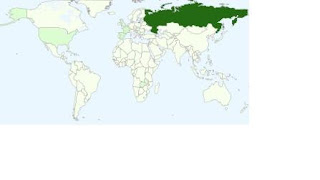What
are these maps?

They represent readers of this blog during the last
months. I looked at my blog stats and saw that a large proportion of
its readers were in Russia. When this first happened, I thought it
a fluke. A blog last fall contained an excerpt from Tug of the
Wishbone. Maureen, the protagonist, discussed Russia with a
boyfriend who traveled there.
My
book, The Swan Bonnet, has characters with mixed heritage. I
arrived at that from the history of Russians in Alaska.
How
interesting, was my initial reaction, to be read where there is a
high standard for published writing. Though I couldn't think of any
Russian women authors in that history.
The
subject of Russian literature really gets me going.
 |
| Modern Library edition, from Amazon.com |
I
read Anna Karenina as an adolescent and afterwards felt that
the book set up a formidable standard for adult literature. Thomas
Hardy stood up to the adultery, illicit love issue but I began to
class many adult books as simply being about adultery. Anna
Karenina was a much bigger book than that. It had quite an
effect on me, choosing to identify with Kitty in the secondary plot.
I
was not so happy with film versions of Anna Karenina. I
couldn’t understand why there was sympathy for Count Karenin. At
thirteen, my understanding was that the government official Karenin
bought the most beautiful young aristocratic woman, Anna, and made
her live an austere, loveless existence until she had a son.
Nineteenth century literature often challenged the compatibility of
the marriage match. It questioned the institution’s integrity.
Lately,
I was involved with a discussion among Facebook writers about tense.
We agreed that writers these days usually write in one tense and that
the present tense throughout a book could feel uncomfortable. I
furnished an example from Tolstoy, his long short story, The
Snowstorm, in which he moved from past to present tense in a
natural way and to step up the pace during a very long sleigh ride.
Dickens also used this technique, evident in the first chapters of
Our Mutual Friend, where it gave immediacy in a dining room
with many characters. Why these techniques are not used so much
among authors today could point to the difference between the old
masters and other authors, we concluded at the discussion.
Crime
and Punishment, I think, was the most compelling book I ever
read. However, some years ago a freshman composition student took me
off-course, asking if I had read The Brothers Karamozov. She
was so enthralled with it. I began reading the book and couldn’t
get involved. Just before the 2016 election, I picked it up again
from my used book stock. The elder Karamozov, repeatedly referred to
as a buffoon, caught me this time. I struggled with the book because
I felt that Dostoyevsky didn’t have the editing that he had for
Crime and Punishment. It was worth the struggle.
 |
| The Brothers Karamozov, International Collectors Edition, from Amazon.com |
When
I felt ennui at the adultery problem in adult novels, I read Cancer
Ward. Solzhenitsyn had accomplished a grand Russian novel with
that as the setting. Later, I read his short story work, and then
looked at The Gulag Archipelago. The pages I read of that book
stunned me so much that I put it off for another time.
In
the 1980’s, I concluded that Sigrid Undset, author of Kristin
Lavransdatter, was the only woman who had written a Russian
novel. (Maybe I’ll get some blog readers from Norway now.)
I
suppose I have spent more time with Russian literature than with
learning about the Cold War.
